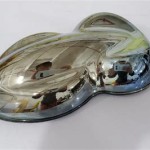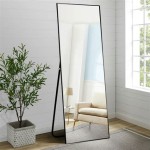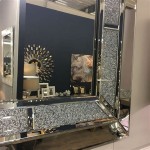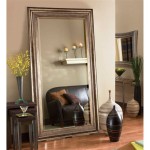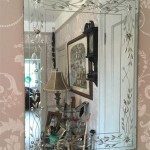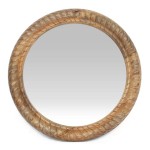Arts and Crafts Antique Mirrors
The Arts and Crafts movement, flourishing from the late 19th to the early 20th century, significantly impacted decorative arts, including mirror design. Arts and Crafts antique mirrors represent a unique intersection of functionality and artistic expression, reflecting the movement's emphasis on handcrafted quality, natural materials, and simple, elegant aesthetics.
Key Characteristics of Arts and Crafts Mirrors
Several key features distinguish Arts and Crafts mirrors from other antique styles. Recognizing these characteristics is essential for collectors and enthusiasts seeking authentic pieces.
Emphasis on Natural Materials
The Arts and Crafts movement celebrated the beauty of natural materials. Oak, mahogany, and cherry were favored woods for mirror frames. Other natural elements, such as copper and hammered metal, often complemented the wood, providing decorative accents and structural support.
Simple, Geometric Designs
Rejecting the ornate Victorian style, Arts and Crafts mirrors embrace simplicity and geometric forms. Rectangular and square shapes are prevalent, often incorporating subtle curves and gentle arches. Decoration, when present, is typically restrained, emphasizing the inherent beauty of the materials.
Handcrafted Quality and Detail
A hallmark of the Arts and Crafts movement was its dedication to handcrafted quality. Mirrors from this period often exhibit meticulous joinery, hand-carving, and other evidence of skilled craftsmanship. The focus on handwork contributed to the unique character and enduring value of these pieces.
Influence of Nature and Medieval Design
Nature served as a primary source of inspiration for Arts and Crafts designers. Stylized floral motifs, leaves, and other natural elements frequently appear in carved or inlaid details on mirror frames. Additionally, the movement drew inspiration from medieval art and architecture, evident in some mirrors' simple lines and structural elements.
Integration with Furniture and Interiors
Arts and Crafts mirrors were designed to harmonize with the overall aesthetic of the interior. They were often integrated into furniture pieces, such as dressing tables and sideboards, or hung as standalone features complementing the room's architecture and décor.
Identifying Authentic Arts and Crafts Mirrors
Given the resurgence of interest in Arts and Crafts style, identifying authentic antique mirrors requires careful examination. Several factors help authenticate these pieces.
Construction Techniques and Materials
Authentic Arts and Crafts mirrors will exhibit the construction techniques and materials typical of the period. Hand-joined frames, the use of solid wood, and the presence of age-appropriate patina are important indicators of authenticity. Modern reproductions often utilize different construction methods and materials.
Maker's Marks and Labels
Some Arts and Crafts mirrors bear maker's marks or labels, providing valuable clues about their origin and authenticity. Known makers and workshops associated with the movement, such as Gustav Stickley and Liberty & Co., increase the value and desirability of these pieces.
Condition and Restoration
The condition of an antique mirror significantly impacts its value. While minor signs of wear are expected, significant damage or poorly executed restorations can detract from the piece's authenticity and desirability. Careful examination is necessary to assess the mirror's condition and any previous restoration work.
Collecting and Caring for Arts and Crafts Mirrors
Collecting Arts and Crafts mirrors can be a rewarding pursuit. Understanding market values and proper care ensures the preservation of these historical artifacts.
Market Value and Appraisal
The market value of Arts and Crafts mirrors varies depending on several factors, including the maker, size, condition, and rarity of the piece. Consulting with a reputable appraiser specializing in antique furniture and decorative arts provides an accurate assessment of a mirror's value.
Preservation and Maintenance
Proper care preserves the beauty and integrity of Arts and Crafts mirrors. Avoiding excessive humidity and direct sunlight helps prevent damage to the wood and reflective surface. Gentle cleaning with appropriate materials safeguards the original finish and patina. Consulting with a professional conservator is advisable for significant repairs or restoration.
Arts and Crafts antique mirrors offer a unique glimpse into a significant design movement. Their handcrafted quality, natural materials, and enduring aesthetic appeal continue to resonate with collectors and enthusiasts today. Careful consideration of the key characteristics, authentication factors, and proper care ensures the preservation of these beautiful and historically significant pieces.

Arts Crafts Antique Dressing Mirror Mission Studio

Antique Arts Crafts Copper Mirror Circa 1900

Swedish Arts And Crafts Hand Carved Oak Mirror With Monkey Birds For At 1stdibs Craft

Arts Crafts Brass Repoussé Mirror Rough Old Glass

Genuine Antique Arts Crafts Copper Mirror Circa 1900

Arts And Crafts Antique Mirror

Liberty Arts And Crafts Copper Mirror C1900 S Antiques To Buy

Scottish Arts Crafts Large Copper Mirror

English Arts Crafts Mirror Repoussé Copper Over Wood Early 20th Century Ht 17 1 2 Wd Art Nouveau Design And Craft Furniture

Arts And Crafts Antique Mirror Wooden Framed White Craig Jones Antiques

